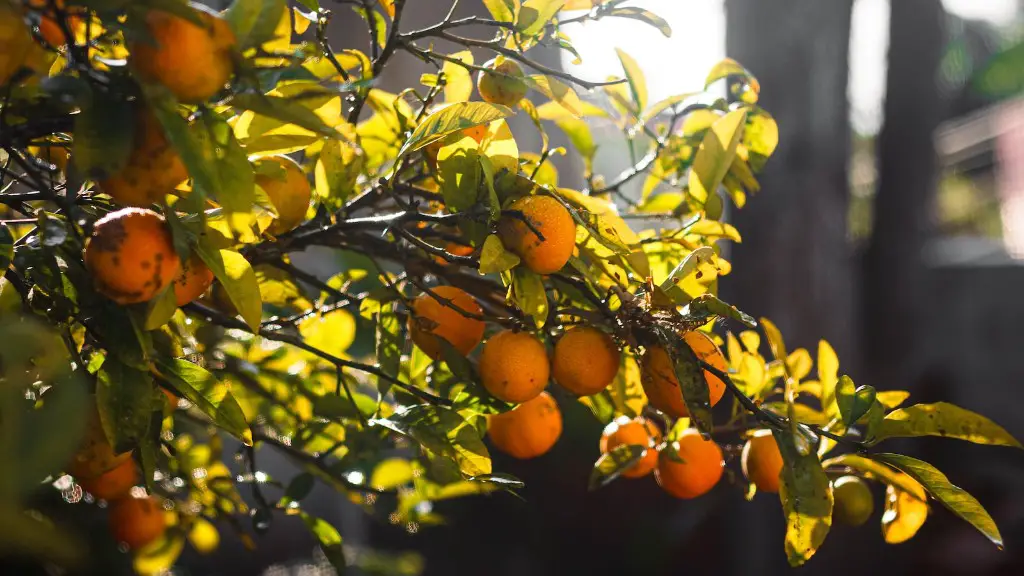The lemon tree is a great and attractive tree found in many parts of the world. It’s often grown for its fragrant flowers and fruit, but it also makes an excellent addition to gardens and landscapes. Lemon trees have a unique growth habit, with a single trunk and branches that grow symmetrically around the trunk in a pyramid shape. The dark green foliage of lemon trees is quite striking and stands out against the bark of the tree. The bark of the lemon tree is usually greyish-brown and is usually quite smooth but may have some furrowed lines. Lemon trees can grow quite tall, often reaching 15-20 ft in height, and they can spread wide, up to 10-15ft in width. The bloom of the lemon tree is also quite striking; its white flowers open up to reveal a red-orange colored center in some varieties. Finally, lemon trees produce edible fruits that are very popular for cooking, baking, and juicing.
The Origin of Lemon Trees
The lemon tree originates from the Middle East and North India, though it has been cultivated and grown in many other parts of the world. Its scientific name is Citrus Limon and there are many different varieties of the tree, such as: the Lisbon, Eureka, and Villafranca varieties. These different varieties have slightly different looks (flower colors, fruits, etc.) and ripening times, so it is important to select the variety that best suits your climate and needs. Lemon trees are relatively hardy and can survive in climates as low as 23 degrees Fahrenheit (-5 °C) when mature, though they need a lot of sunshine and warmth to produce their best yields.
Lemon Tree Care
Lemon trees need a lot of sunshine and protection from strong winds. They prefer a neutral soil and do not like to be overly wet or waterlogged. Pruning a lemon tree is essential for good growth and health, as it will keep the tree in control and encourage more fruits to form. To prune a lemon tree, it’s important to remove damaged branches and anything that is dead or dying. It’s also important to remove any branches that are growing too closely together; leaving them will cause them to shade out one another and stunt the growth of the tree. In terms of care and maintenance, lemon trees should be watered frequently when young, and during periods of drought, it’s important to ensure that the soil remains moist. Lemon trees also require a fertilizer twice a year; once in early spring, and then again in mid-summer.
Benefits of the Lemon Tree
The lemon tree offers many benefits to both gardeners and landscapes. For one, the flowers and fruits of this tree give any garden a unique and attractive touch. The fragrance of the blossoms is also quite calming, making it perfect for garden sitting and reading. Additionally, the fruits of the lemon tree are packed full of antioxidants and vitamins such as vitamin C, as well as providing a sour citrus flavor to dishes. In terms of landscape benefits, the lemon tree is a great choice for those who want to add a tall, upright element to any garden. The tree also makes a great wind-break or shade tree in sunny areas, and can be used to create a stunning centerpiece for any garden.
Uses of Lemon Trees
Lemon trees are not only aesthetically pleasing but they are also very practical. The fruits of this tree can be used in a variety of ways; they can be juiced, used to make sauces and dressings, made into lemonades, and even used to give dishes a bright and tart flavor. Lemon trees can also be used in the production of oil, which is then used in aromatherapy and perfumes. The bark and leaves of the tree can also be used in various applications such as making teas, medicinal tinctures, and even as a natural pest repellant.
Growing Conditions of Lemon Trees
To get the best yields from lemon trees, it’s important to provide them with the proper growing conditions. Lemon trees prefer full sun and warm temperatures, so if possible, try to plant the tree in an area of the garden where it will get 6-8 hours of direct sunlight. The soil should also be moist, but not waterlogged; having sandy loam soil will help to ensure that the tree receives adequate water and nutrients. Additionally, lemon trees should be pruned in late winter or early spring, just before they start to bloom, to ensure that they don’t get too heavy or crowded.
Lemon Tree Varieties
There are many different varieties of lemon trees available, such as: the Lisbon, Eureka, and Villafranca varieties. Each has its own unique characteristics and fruits, so it is important to consider the needs of your specific location and climate. Lisbon lemon trees are slightly more cold-tolerant than other varieties and are often used to make lemonade because of their sweet flavor and abundance of juice. The smaller Eureka variety is known to be more tart and acidic, while the Villafranca variety is known for its hardy nature, high yields, and thick skinned fruits. All varieties require similar growing conditions and care, so it is essential to do research and select the variety that is best suited for your needs.
Nutritional Profile of Lemon Trees
One of the great benefits of lemon trees is the nutritional value they provide. Lemons contain a great number of nutrients and vitamins, such as: vitamin C, calcium, magnesium, potassium, and folate. Additionally, lemons are rich in antioxidants which can help to reduce inflammation, improve heart health, support immune health, and even have anti-cancer properties. As with other citrus fruits, lemon juice also contains citrate which can help to support kidney health and bladder health.
Lemon Tree Pests and Disease
Though lemon trees are generally pest and disease resistant, there are some potential problems that gardeners should be aware of. Potentially the most destructive pest of the lemon tree is the citrus mealybug, which can quickly defoliate and weaken a tree if left unchecked. It’s important to keep an eye out for signs of infestation and take action as soon as possible if one is found. Other pests and diseases to look out for include aphids, mites, scale insects, and fungus diseases such as cercospora leaf spot and citrus canker. It’s important to check the tree regularly and to apply insecticides and fungicides as necessary to keep the pests and diseases at bay.
Harvesting Lemon Trees
Lemon trees tend to produce their fruits in late winter and early spring, though some varieties may ripen later in the season. To ensure optimal ripening, it’s important to check the tree for ripeness every few weeks and harvest when the fruits are still green, but just beginning to yellow. They should be plucked from the tree gently and should be stored at room temperature for up to two weeks if not eaten immediately. The fruits of the tree can also be frozen for longer term storage.


